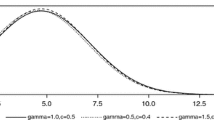Abstract.
Tests of the Fisher effect are plagued by high persistence in interest rates. Instead of standard regression analysis and asymptotic results, methods relying on local-to-unity asymptotics are employed in testing for the Fisher effect with monthly U.S. data covering the period 1953:1–1990:12. These procedures are extensions of a recently presented method (Cavanagh, Elliott and Stock (1995)) based on simultaneous confidence intervals, and they have the advantage of being asymptotically valid whether interest rates are integrated of order one or zero, or near unit root processes. Taking appropriately account of the near unit root problem the findings in most of the previous literature are reconfirmed. There is support for the Fisher effect in the interest rate targeting period (1953:1–1979:10) of the Federal Reserve but not in the 1979:11–1990:12 period.
Similar content being viewed by others
Author information
Authors and Affiliations
Additional information
First version received: July 1999/Final version received: April 2000
Rights and permissions
About this article
Cite this article
Lanne, M. Near unit root and the relationship between inflation and interest rates: A reexamination of the Fisher effect. Empirical Economics 26, 357–366 (2001). https://doi.org/10.1007/s001810000044
Issue Date:
DOI: https://doi.org/10.1007/s001810000044



